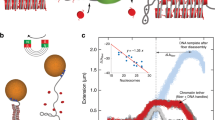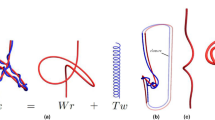Abstract
For DNA in solution, there have been two methods for measuring the helical periodicity. One method1,2 examines the ladder of discrete bands formed in the electrophoretic pattern of supercoiled DNA. Such a ladder is assumed to reflect the set of differently linked covalently closed molecules. The other method3,4 measures the lengths of partial nuclease digestions of DNA segments affixed to flat surfaces. Neither method, however, is able to measure the absolute handedness. X-ray diffraction of DNA oligonucleotides can determine the handedness5–7, but the DNA must necessarily be crystallized. We have developed a new method for determining the helical parameters of a segment of DNA in solution. It is the first non-crystallographic method that can directly determine both the helical periodicity and the absolute handedness of DNA. The results obtained using this method are consistent with the classical Watson–Crick right-handed double helical model8.
This is a preview of subscription content, access via your institution
Access options
Subscribe to this journal
Receive 51 print issues and online access
$199.00 per year
only $3.90 per issue
Buy this article
- Purchase on Springer Link
- Instant access to full article PDF
Prices may be subject to local taxes which are calculated during checkout
Similar content being viewed by others
References
Wang, J. C. Proc. natn. Acad. Sci. U.S.A. 76, 200–203 (1979).
Peck, L. C. & Wang, J. C. Nature 292, 375–378 (1981).
Liu, L. F. & Wang, J. C. Cell 15, 979–984 (1978).
Rhodes, D. & Klug, A. Nature 286, 573–578 (1980); 292, 378–380 (1981).
Wing, R. et al. Nature 287, 755–758 (1980).
Dickerson, R. E. & Drew, H. R. J. molec. Biol. 149, 761–786 (1981).
Drew, H. R., Samson, S. & Dickerson, R. E. Proc. natn. Acad. Sci. U.S.A. 79, 4040–4044 (1982).
Watson, J. & Crick, F. H. C. Nature 171, 737–738 (1953).
Crick, F. H. C. Proc. natn. Acad. Sci. U.S.A. 73, 2639–2643 (1976).
Messing, J. & Vieira, J. Gene 19, 269–276 (1982).
Rhoades, M. & Thomas, C. A. Jr J. molec. Biol. 37, 41–61 (1968).
Author information
Authors and Affiliations
Rights and permissions
About this article
Cite this article
Iwamoto, S., Hsu, MT. Determination of twist and handedness of a 39-base pair segment of DNA in solution. Nature 305, 70–72 (1983). https://doi.org/10.1038/305070a0
Received:
Accepted:
Issue Date:
DOI: https://doi.org/10.1038/305070a0
Comments
By submitting a comment you agree to abide by our Terms and Community Guidelines. If you find something abusive or that does not comply with our terms or guidelines please flag it as inappropriate.



